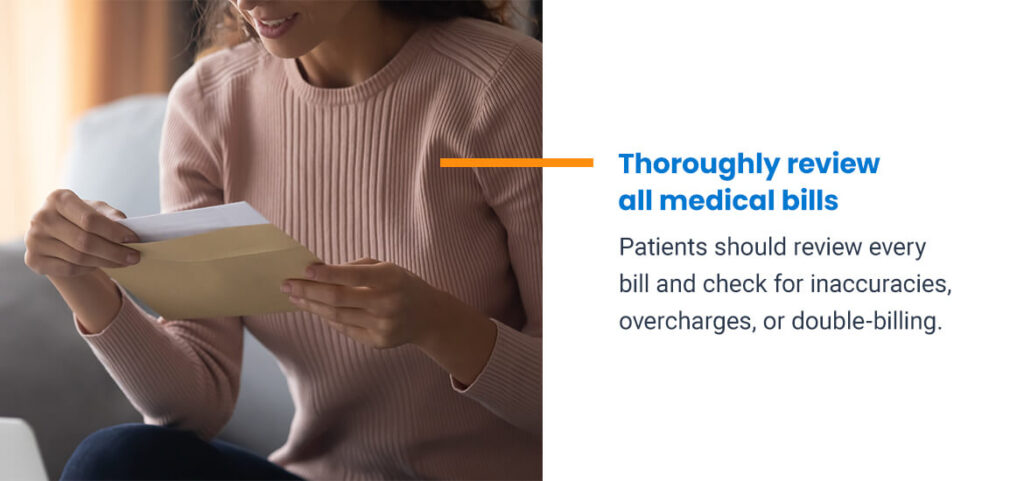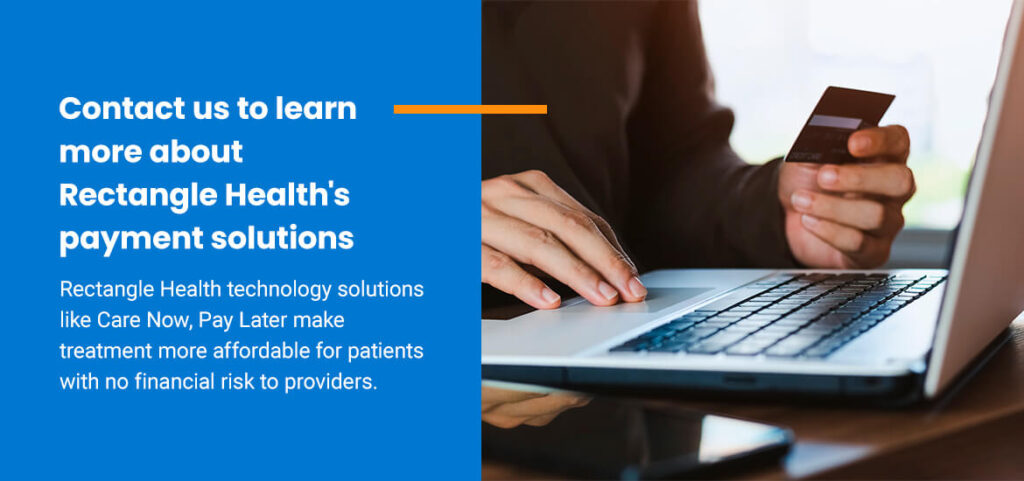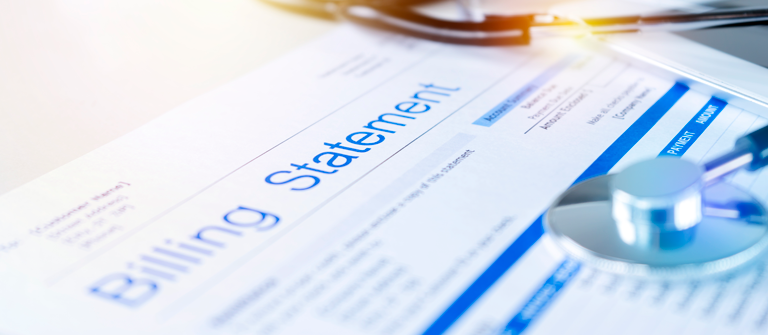The number of people in the United States with medical insurance is at an all-time high, yet there are still 29.6 million people under the age of 65 without coverage. Unexpected medical bills can take a bite out of a person’s savings, even with insurance. Many patients might wonder if they can pay medical bills with a credit card to obtain the care they need faster.
Paying medical bills on a credit card can be a viable option for many patients. Understanding the best times for patients to use their credit cards to pay medical bills can help your healthcare clinic or organization determine how to serve patients best.
Can Patients Pay Medical Bills with a Credit Card?
Most healthcare providers will accept credit cards as a form of payment for medical debt. Individuals have several options available when they need to pay medical bills, and a credit card may be one of the most convenient, especially if they’re uninsured. This option may appeal to many patients who prefer to handle lingering medical bills as quickly as possible.
Individuals considering this form of payment should carefully examine all the factors involved. Although credit cards offer convenience and other perks, it’s often best to avoid using one to pay medical costs.
Pros and Cons of Paying Medical Bills with a Credit Card
Paying for healthcare costs with a credit card has benefits and disadvantages. Consider some of the pros of using this payment method to pay medical bills:
- Convenience: Credit cards are convenient payment options when an individual doesn’t have cash, a check, or insurance.
- Low-interest period: Some credit cards offer low-interest or no-interest periods, so paying bills during this time can mean lower interest rates.
- Rewards: Many credit cards offer perks for a certain amount of usage, such as airline miles or cashback.
- Build credit history: Making credit card payments on time helps build a person’s positive credit score.
Despite these potential advantages, using a credit card to pay medical costs also has some cons:
- Creating debt and interest: When credit card bills are not settled promptly, it can lead to escalating debt due to interest rates. Conversely, medical bills typically do not accrue interest, differentiating it from the financial burden of credit card debt.
- Showing up in credit reports: Failing to pay credit card bills on time can result in the credit card company reporting the late payment to the credit bureaus, which can hurt a person’s credit score.
- Paying for services insurance will cover: If an individual has medical insurance, paying medical bills with a credit card could be unnecessary.
When Does Using a Credit Card for Medical Bills Make Sense?
Although there are some significant disadvantages to using a credit card for paying medical debt, there are several instances when it could be a good move. Individuals may opt for this payment method when they:
- Can pay the balance by the bill’s due date: If a person is confident they’ll have the money for the bill before it’s due, they can avoid creating more medical debt and hurting their credit score.
- Want to avoid debt collection: If a medical facility is threatening someone with a collection amount, paying with a credit card may be the fastest way to settle the bill.
- Have an emergency: When an individual experiences an unexpected medical emergency, paying with a credit card may be their only option.
Tips for Paying Medical Bills
Individuals who want to pay medical bills with a credit card should be aware of the risks involved. If they decide to go this route, a few tips for avoiding higher debt and hurting their credit score can be helpful to keep in mind:

Thoroughly Review all Medical Bills
It’s essential for people to carefully review their medical bills before paying. The U.S. Consumer Financial Protection Bureau recently reported that mistakes on medical bills are common. Patients should review every bill and check for inaccuracies, overcharges, or double-billing. There could also be mistakes in the codes used to determine the amount a patient owes. Contacting the healthcare provider will help clear up any minor errors and ensure patients aren’t overpaying.
Negotiate with Your Healthcare Provider
If a patient pays with a credit card, they often have a bit of negotiating power they can use to lower their bill. Here are a few best practices for negotiating prices with a healthcare provider:
- Review the insurance company’s explanation of benefits (EOB): There could be an item on a bill that should have been covered by insurance.
- Look for alternative payment methods: Other payment sources like payment plans could be available, depending on a person’s situation.
- Talk to the healthcare provider: Discussing the medical debt with the healthcare provider could convince them to reduce the price.
Alternative Ways to Pay Medical Bills
Using a credit card to pay medical costs could be a viable option. However, the increased risk of accumulating debt means it’s often better for patients to keep their cards in their wallets. Instead, there may be other options available for paying these bills:
Get a Home Equity Line of Credit
A home equity line of credit (HELOC) allows people to borrow against the equity they’ve built up in their homes through their mortgages. An individual who uses a HELOC to pay medical expenses has an extended period to pay back the loan. Interest rates for HELOCs are usually much lower than credit card interest rates.
However, borrowing through a HELOC requires the individual to have a specific credit score and equity in their home, and an individual’s home also becomes collateral for this loan.
Get a Personal Loan
Another option is to take out a personal loan. These loans differ from student loans and other types of debt because the loans can be used to pay for a wide range of medical expenses. Personal loans have a fixed rate and don’t require collateral.
A disadvantage of using a personal loan to pay medical bills is the strict credit score requirements and the need for a low debt-to-income ratio. Individuals should check a personal loan’s interest rate, as it varies by provider.
Set up a Payment Plan
Some hospitals and healthcare providers offer payment plans to low-income individuals. These plans are often interest-free, a significant advantage over the other options listed here.
Individuals who use a medical bill payment plan should be confident they can afford the monthly costs. Healthcare providers also generally require people to be below a certain income level to use a payment plan.
Rectangle Health Can Help You Afford Care
When your healthcare organization’s patients have no choice but to pay with a credit card, offering flexible payment options benefits them and makes you more competitive. At Rectangle Health, we offer healthcare technology like our patient financing solution, to help healthcare providers better manage patient financing. CNPL is a non-recourse financing arrangement that helps patients afford the care they need regardless of their credit scores.
By partnering with Rectangle Health and Healthcare Finance Direct, your healthcare organization can receive payment shortly after patients start payment plans with Healthcare Finance Direct. With unmatched industry approval rates*, we open up the opportunity for patients to obtain financing for treatment. Patients receive multiple payment terms quickly after application, and they’re always approved for the full amount. Your patients can choose the down payment option that best fits their budget, making it easier for them to say “yes” to care.

Contact Us to Learn More About Rectangle Health’s Payment Solutions
When your patients want to pay for their medical bills with a credit card, providing practical payment options makes it easier for them to finance their healthcare costs. Rectangle Health technology solutions like Patient Financing make treatment more affordable for patients with no financial risk to providers. Healthcare providers that offer CNPL can be assured that their patient financing is just as helpful for their patients as it is for their practice.
At Rectangle Health, we’ve been developing innovative payment technology for the healthcare industry for almost 30 years and have built solutions that make payment faster for practices and easier for patients. To learn more, schedule a demo today.
* The Patient Financing program provides nearly 100% approval. Applicants determined to be in Open Bankruptcy, Fraud Alert or on the Terrorist Watch List during the application process will be declined. Patients covered by government payor programs for a procedure are not eligible for financing of that procedure. Government payer programs include Medicare, Medicaid, the State Children’s Health Insurance Program (SCHIP), the Department of Defense TRICARE and TRICARE for Life programs (DOD TRICARE), the Veterans Health Administration (VHA) program, and the Indian Health Service (IHS) program.]
References
- Consumer Finance. (2022, March 1). CFPB estimates $88 billion in medical bills on credit reports. Consumer Financial Protection Bureau. https://www.consumerfinance.gov/about-us/newsroom/cfpb-estimates-88-billion-in-medical-bills-on-credit-reports/.
- National Center for Health Statistics. (2022, September 6). Health insurance coverage. Centers for Disease Control and Prevention. https://www.cdc.gov/nchs/fastats/health-insurance.htm.
- Statista. (2022, September). Number of people with health insurance in the United States from 1990 to 2021. https://www.statista.com/statistics/200946/americans-with-health-insurance/.



